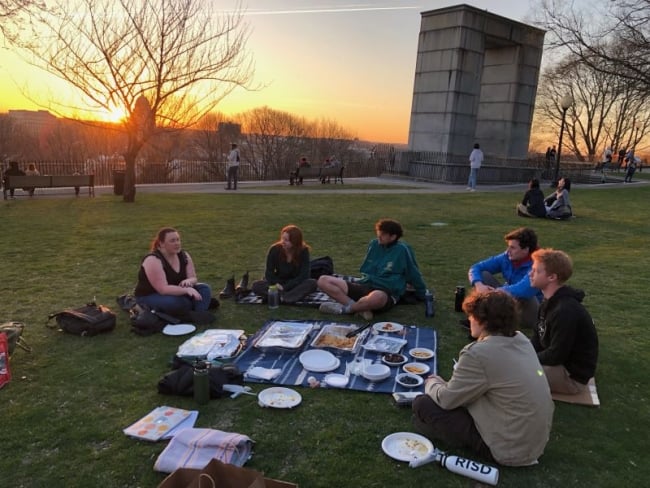You have /5 articles left.
Sign up for a free account or log in.

Jewish students at Brown University gather for a Hillel event.
Brown RISD Hillel
Alumni and parents of traditionally observant Jewish students at the University of Pennsylvania gathered on Zoom earlier this year with leaders of the university’s Hillel, a campus organization for Jewish students. The meeting was to discuss declining Jewish enrollment, particularly among Orthodox students.
Rabbi Gabe Greenberg, executive director of the Hillel, called the group together that February day after having “dozens if not a hundred” conversations with parents concerned about the shrinkage of Penn’s Jewish population. The campus has historically been known as having among the most robust Jewish communities in the country, with ample resources for students who traditionally observe Shabbat and keep kosher.
Jewish students accounted for about a third of enrollment several decades ago and now make up just roughly 16 percent of the 10,412 undergraduates at Penn. The number of observant students, which reached 200 in the early 2000s, has since dropped to about 70.
That’s still a sizable group, especially given that Jews are only about 2 percent of the U.S. population, Greenberg said. But he finds the decline has affected aspects of Jewish social and religious life on campus. For example, Orthodox students traditionally serve as mashgiachs, supervisors who ensure the kosher dining hall properly meets Jewish dietary restrictions, but it’s become harder to find students to fill those roles. Students who traditionally observe Shabbat by not using electronic devices on Friday nights and Saturdays, and sharing communal meals, also find the experience lonelier with fewer students on campus who hold the same traditions.
Greenberg said having a diverse Jewish community, including members of the LGBTQ community, Jews of color and from different geographic backgrounds and denominations, or who are nondenominational, is critical.
“At Penn, many seek to realize a diverse and inclusive campus community, and we strongly believe that a strong, robust and diverse Jewish community is part of what makes that happen,” he said.
Greenberg noted the historic national rise in antisemitism—including on college campuses—and said Jewish students need a sense of community more than ever.
“We are deeply concerned that a decline in Jewish students at this exact moment … both sends the wrong message and concretely negatively affects the lived experience of Jewish students on campus,” he said.
The downward trend in Jewish enrollment isn’t unique to Penn. The numbers have notably declined at most Ivy League institutions in the last few decades. And Jewish students are in turn increasingly going to universities, within and outside the Ivies, that historically had smaller numbers of Jews enrolled.
The Jewish Telegraphic Agency, a Jewish news wire service, reported in 1967 that Jewish students had reached high numbers at the Ivies after decades of low enrollments. The news outlet cited a New York Times survey at the time, which found that the student bodies at Columbia University and University of Pennsylvania were 40 percent Jewish. Jewish student populations at Harvard, Yale and Cornell were estimated to be between 20 and 25 percent, while those at Dartmouth, Princeton and Brown hovered between 13 and 20 percent.
Jews now make up 9.9 percent of Harvard’s undergraduate enrollment and 12.2 percent at Yale, according to estimates on Hillel’s website. The share of Jewish students at Columbia University is an estimated 22.3 percent. Roughly 8.8 percent of Dartmouth students, and 9.6 percent of Princeton students, are Jewish. Cornell and Brown are the only two Ivies to buck the trend of significant declines compared to the 1960s, with Jewish students making up 21.5 percent and 23.9 percent, respectively, of the enrollment.
The shifts evoke mixed feelings within campus Jewish communities. Some are sad to see vibrant communities shrink, while others welcome it as a sign that Jewish students feel at home on more campuses. Some see it as a by-product of more universities providing supports and programming that cater to Jewish students and the Ivies seeking to diversify their student bodies.
Leonard Saxe, who directs the Steinhardt Social Research Institute and Cohen Center for Modern Jewish Studies at Brandeis University, said it’s hard to get an accurate count of Jewish students because universities don’t necessarily keep track of them, and if they do, it’s usually through surveys that ask students to identify their religion. Some Jews consider themselves culturally as opposed to religiously Jewish and might not check the box if it’s a religious subcategory. However, Saxe and colleagues did studies of Jewish life at Harvard and Penn that showed downward enrollment trends.
“Jewish students now go to a much larger number of schools than was ever the case,” he said. “Twenty years ago, 30 years ago, 40 years ago, there might have been 100 to 150 schools, which were the only schools Jewish students went to. Today there are hundreds and hundreds of schools.”
Hillel professionals and scholars listed a number of universities that, at least anecdotally, seem to be attracting Jewish students more than in the past, including Vanderbilt, Brown, the University of Chicago, Tulane University and Elon University.
A Fraught History
Jewish enrollment has a troubled history. A century ago, Ivies in the Northeast, such as Harvard, Yale and Columbia University, sought to artificially lower the number of Jewish students at their institutions.
Harvard applicants, for example, were asked questions, such as their mother’s maiden names, to suss out if they were Jewish, said Marcia Graham Synnott, professor emerita of history at the University of South Carolina. Harvard officials were also careful not to assign too many Jewish student to the dorms, she said. These strategies reflected a growing “anti-immigration sentiment in the United States” as the children of Jewish immigrants from Eastern Europe and elsewhere flocked to these institutions, said Synnott, who’s written extensively about the history of discrimination in Ivy League admissions against Jews and other groups.
Discriminatory policies toward Jewish applicants at the Ivies started shifting after World War II, and “Americans had to think about what they were fighting for,” she said. Some of the more subtle restrictions persisted on into the 1950s but ebbed considerably again in the 1960s with the onset of the civil rights movement.
She noted that the issue touches on a larger national debate, as the U.S. Supreme Court is expected to rule on race as a factor in admissions this summer.
She views affirmative action in higher ed as institutions trying to right historic wrongs and “trying to be inclusive and keep some sort of balance.”
Mark Oppenheimer, the host of Gatecrashers, a podcast about the history of Jewish quotas at the Ivies, said Jewish enrollment declines used to be the result of intentional policies designed to keep them out.
“Today I don’t think there’s anyone in college admissions who’s deliberately trying to squeeze Jews out,” he said. But he believes admissions priorities at the Ivies and demographic trends within Jewish communities themselves have shifted in ways that affect Jewish enrollments.
“The quest for greater racial diversity makes it a little harder for many applicants who are perceived as white to get in,” he said. He also noted that the Ivies put an emphasis on recruiting international students, who often happen to be from countries without large Jewish populations. Some Jewish denominations in America have also shrunk, which could be contributing to the trend, he added.
A Complex Present and Future
Hillel professionals and scholars are conflicted about whether it’s a positive, negative or neutral development that Jewish enrollment is trending down at some of the Ivies and growing at other institutions.
Joyce Gordon, director of Jewish life at Duke University, said she disagrees with the idea that the “sky is falling” because Jewish students are enrolling elsewhere. The Jewish student population at Duke has grown from 10 percent to 12 percent of undergraduates over the last five years.
For one thing, she doesn’t believe the enrollment data are clear. She noted that, if campuses track Jewish student numbers at all, she doesn’t know how they’re categorizing Jews of color, who increasingly make up younger Jewish populations. She added that it’s unclear how many Jewish high school grads are even applying to the Ivies. She said they could be going to other colleges for any number of reasons, including lower costs, and they seem to be thriving elsewhere.
She’s also disturbed by the narrative that Jewish and underrepresented students are vying for seats.
“The hand-wringing that is out there about declining Jewish enrollment, if there is declining Jewish enrollment, it can’t come at the expense of celebrating increasing enrollment—of other minoritized groups,” she said.
She’s read articles about this issue that she believes “tread very close to the line, if not over the line, on racial animus.”
Joshua Bolton, executive director of Hillel at Brown University, said Jewish students are going to different campuses in part because more campuses now have the infrastructure to support them, such as kosher dining halls. Brown, for example, is building two new kosher kitchens set to open this fall, and Hillel has a beit midrash, a Jewish library where students can study texts together.
The Jewish community at Brown appears to be growing. Bolton estimates that 30 percent of the student body participated in Hillel programming this academic year, and about 11 percent of undergraduates participated in campus Passover seders this semester.
He attributes the vibrancy of the community to messaging by campus leaders.
“Fast-tracking the building of two new kosher kitchens is not something you see very often,” he said, noting that Brown president Christina Paxson, who’s Jewish, has “been very open about her desire to see the growth of a more diverse campus community and the extent to which Jewish life plays an important role in that tapestry.”
He believes more supports for Jewish students at more universities is a positive thing.
“We want Jewish students to feel comfortable everywhere,” he said.
At the same time, some observers described a sense of loss on campuses where Jewish life was once more robust.
“There was definitely something poetic and poignant and beautiful about the confident, large Jewish presence in the 1980s and ’90s of a group that was historically discriminated against and squeezed out of these schools,” Oppenheimer said. “To see large communities at Yale, Harvard and Columbia when, just 50 years earlier, these schools were trying really hard to keep their numbers under 10 percent, was a tremendous testament to both immigrant perseverance and also America’s willingness to change and its capacious generosity.”
When Oppenheimer went to Yale as an undergraduate in the mid-1990s, there was a large Jewish presence.
“I took it for granted, which also might be a beautiful thing, that I didn’t feel like I was in a fight for belonging,” he said. “I felt like I was permitted and allowed and maybe even entitled to be there,” unlike generations before him.
He added that there’s an enhancement of “cultural life that comes with critical mass” for any group.
“For Black students who were 5 percent of Harvard 30 or 40 years ago to be 12 or 13 percent really improves the quality of life for all Black students, because it allows for more different varieties of cultural and intellectual expression,” he said. “So, there is a sense in which, when any group has large numbers then shrinks, there is an impoverishment of that group’s experience at the school. It may open up other avenues for learning … but there’s also a real loss that goes with it.”
Some Hillel leaders emphasized that having a campus community of a certain size significantly helps Orthodox students who otherwise may have a harder time getting accommodations, such as class time off for holidays, or assembling a minyan, a group of 10 men required for Orthodox prayer services.
Greenberg said Hillel leaders have been discussing the Jewish enrollment drop with university leaders because he sees Penn’s diverse Jewish community as a piece of university history that risks being lost.
“Penn has a beautiful heritage of being a place where Jewish students could thrive in one of the top schools in the nation,” he said. “It would be a deep loss to the Jewish community and, we feel, to Penn, to lose that historic connection.”









